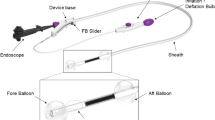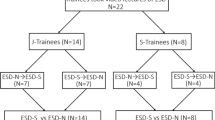Abstract
Background
Endoscopic submucosal dissection (ESD) is an optimal treatment for colorectal tumors; however, it is technically difficult, especially for non-experts. Therefore, a device that helps non-experts perform colorectal ESD would be beneficial. A double-balloon endolumenal interventional platform (DEIP) was recently developed to assist colorectal ESD through endoscope stabilization and traction. This study assessed the usefulness of colorectal ESD using the DEIP (DEIP-ESD) by endoscopists, including non-experts, in a living porcine model.
Methods
Two pigs were used to perform eight DEIP-ESD and eight conventional cap-assisted ESD (C-ESD) procedures. Three experts and five non-experts each resected one lesion using DEIP-ESD and one using C-ESD. We evaluated the treatment outcomes and performed stratified analyses between the experts and non-experts.
Results
Dissection speed was significantly faster in DEIP-ESD than in C-ESD (13.3 mm2/min vs 28.5 mm2/min, P = 0.002). However, the total procedure time did not differ significantly between DEIP-ESD and C-ESD. In the stratified analyses, the dissection speed of non-experts was significantly faster in DEIP-ESD than in C-ESD (10.9 mm2/min vs 25.1 mm2/min, P = 0.016), while that of experts increased in DEIP-ESD but to a lesser extent (19.1 mm2/min vs 28.8 mm2/min, P = 0.1). The total procedure time did not differ between DEIP-ESD and C-ESD for both experts and non-experts. The self-completion rate of non-experts also increased in DEIP-ESD. Moreover, the number of muscularis propria injuries induced by non-experts was fewer in DEIP-ESD than in C-ESD.
Conclusions
DEIP could facilitate colorectal ESD by improving dissection efficiency without increasing adverse events, especially when performed by non-experts.





Similar content being viewed by others
References
Winawer SJ, Zauber AG, Ho MN, O’Brien MJ, Gottlieb LS, Sternberg SS, Waye JD, Schapiro M, Bond JH, Panish JF, Ackroyd F, Shike M, Kurtz RC, Lewis-Hornsby L, Gerdes H, Stewart ET, National Polyp Study Workgroup (1993) Prevention of colorectal cancer by colonoscopic polypectomy. The National Polyp Study Workgroup. N Engl J Med 329:1977–1981
Zauber AG, Winawer SJ, O’Brien MJ, Lansdorp-Vogelaar I, van Ballegooijen M, Hankey BF, Shi W, Bond JH, Schapiro M, Panish JF, Stewart ET, Waye JD (2012) Colonoscopic polypectomy and long-term prevention of colorectal-cancer deaths. N Engl J Med 366:687–696
Fujiya M, Tanaka K, Dokoshi T, Tominaga M, Ueno N, Inaba Y, Ito T, Moriichi K, Kohgo Y (2015) Efficacy and adverse events of EMR and endoscopic submucosal dissection for the treatment of colon neoplasms: a meta-analysis of studies comparing EMR and endoscopic submucosal dissection. Gastrointest Endosc 81:583–595
Saito Y, Uraoka T, Yamaguchi Y, Hotta K, Sakamoto N, Ikematsu H, Fukuzawa M, Kobayashi N, Nasu J, Michida T, Yoshida S, Ikehara H, Otake Y, Nakajima T, Matsuda T, Saito D (2010) A prospective, multicenter study of 1111 colorectal endoscopic submucosal dissections (with video). Gastrointest Endosc 72:1217–1225
Hotta K, Oyama T, Shinohara T, Miyata Y, Takahashi A, Kitamura Y, Tomori A (2010) Learning curve for endoscopic submucosal dissection of large colorectal tumors. Dig Endosc 22:302–306
Imai K, Hotta K, Yamaguchi Y, Kakushima N, Tanaka M, Takizawa K, Kawata N, Matsubayashi H, Shimoda T, Mori K, Ono H (2016) Preoperative indicators of failure of en bloc resection or perforation in colorectal endoscopic submucosal dissection: implications for lesion stratification by technical difficulties during stepwise training. Gastrointest Endosc 83:954–962
Mizutani H, Ono S, Ohki D, Takeuchi C, Yakabi S, Kataoka Y, Saito I, Sakaguchi Y, Minatsuki C, Tsuji Y, Niimi K, Kodashima S, Yamamichi N, Fujishiro M, Koike K (2017) Recent development of techniques and devices in colorectal endoscopic submucosal dissection. Clin Endosc 50:562–568
Yamashina T, Nemoto D, Hayashi Y, Fukuda H, Okada M, Takezawa T, Aizawa M, Sakamoto H, Miura Y, Sunada K, Lefor AK, Togashi K, Yamamoto H (2020) Prospective randomized trial comparing the pocket-creation method and conventional method of colorectal endoscopic submucosal dissection. Gastrointest Endosc 92:368–379
Sakamoto N, Osada T, Shibuya T, Beppu K, Matsumoto K, Shimada Y, Konno A, Kurosawa A, Nagahara A, Ohkusa T, Ogihara T, Watanabe S (2008) The facilitation of a new traction device (S-O clip) assisting endoscopic submucosal dissection for superficial colorectal neoplasms. Endoscopy 40(Suppl 2):E94-95
Sakamoto N, Osada T, Shibuya T, Beppu K, Matsumoto K, Mori H, Kawabe M, Nagahara A, Otaka M, Ogihara T, Watanabe S (2009) Endoscopic submucosal dissection of large colorectal tumors by using a novel spring-action S-O clip for traction (with video). Gastrointest Endosc 69:1370–1374
Osada T, Sakamoto N, Shibuya T, Beppu K, Matsumoto K, Shimada Y, Mori H, Konno A, Kurosawa A, Nagahara A, Otaka M, Ohkusa T, Ogihara T, Watanabe S (2008) “Loops-attached rubber band” facilitation of endoscopic submucosal dissection of superficial colorectal neoplasm. Endoscopy 40(Suppl 2):E101-102
Okamoto K, Muguruma N, Kitamura S, Kimura T, Takayama T (2012) Endoscopic submucosal dissection for large colorectal tumors using a cross-counter technique and a novel large-diameter balloon overtube. Dig Endosc 24(Suppl 1):96–99
Sharma S, Momose K, Hara H, East J, Sumiyama K, Nakajima K, Silbehumer G, Milsom J (2019) Facilitating endoscopic submucosal dissection: double balloon endolumenal platform significantly improves dissection time compared with conventional technique (with video). Surg Endosc 33:315–321
du Percie SN, Hurst V, Ahluwalia A, Alam S, Avey MT, Baker M, Browne WJ, Clark A, Cuthill IC, Dirnagl U, Emerson M, Garner P, Holgate ST, Howells DW, Karp NA, Lazic SE, Lidster K, MacCallum CJ, Macleod M, Pearl EJ, Petersen OH, Rawle F, Reynolds P, Rooney K, Sena ES, Silberberg SD, Steckler T, Wurbel H (2020) The ARRIVE guidelines 20: Updated guidelines for reporting animal research. PLoS Biol 18:e3000410
Hayashi Y, Shinozaki S, Sunada K, Sato H, Miura Y, Ino Y, Horie H, Fukushima N, Lefor AK, Yamamoto H (2016) Efficacy and safety of endoscopic submucosal dissection for superficial colorectal tumors more than 50 mm in diameter. Gastrointest Endosc 83:602–607
Cotton PB, Eisen GM, Aabakken L, Baron TH, Hutter MM, Jacobson BC, Mergener K, Nemcek A Jr, Petersen BT, Petrini JL, Pike IM, Rabeneck L, Romagnuolo J, Vargo JJ (2010) A lexicon for endoscopic adverse events: report of an ASGE workshop. Gastrointest Endosc 71:446–454
Kanda Y (2013) Investigation of the freely available easy-to-use software “EZR” for medical statistics. Bone Marrow Transplant 48:452–458
Mori H, Kobara H, Nishiyama N, Fujihara S, Matsunaga T, Masaki T (2017) Novel effective and repeatedly available ring-thread counter traction for safer colorectal endoscopic submucosal dissection. Surg Endosc 31:3040–3047
Ritsuno H, Sakamoto N, Osada T, Goto SP, Murakami T, Ueyama H, Mori H, Matsumoto K, Beppu K, Shibuya T, Nagahara A, Ogihara T, Watanabe S (2014) Prospective clinical trial of traction device-assisted endoscopic submucosal dissection of large superficial colorectal tumors using the S-O clip. Surg Endosc 28:3143–3149
Yamasaki Y, Takeuchi Y, Uedo N, Kanesaka T, Kato M, Hamada K, Tonai Y, Matsuura N, Akasaka T, Hanaoka N, Higashino K, Ishihara R, Okada H, Iishi H (2018) Efficacy of traction-assisted colorectal endoscopic submucosal dissection using a clip-and-thread technique: A prospective randomized study. Dig Endosc 30:467–476
Yamashina T, Hayashi Y, Sakamoto H, Yano T, Miura Y, Shinozaki S, Sunada K, Kawarai Lefor A, Yamamoto H (2018) Balloon-assisted endoscopy facilitates endoscopic submucosal dissection of difficult superficial proximal colon tumors. Endoscopy 50:800–808
Asayama N, Oka S, Tanaka S, Sumimoto K, Hirano D, Tamaru Y, Ninomiya Y, Shigita K, Hayashi N, Nishiyama S, Chayama K (2016) Clinical usefulness of a single-use splinting tube for poor endoscope operability in deep colonic endoscopic submucosal dissection. Endosc Int Open 4:E614-617
Li B, Shi Q, Xu EP, Yao LQ, Cai SL, Qi ZP, Sun D, He DL, Yalikong A, Lv ZT, Zhou PH, Zhong YS (2021) Prediction of technically difficult endoscopic submucosal dissection for large superficial colorectal tumors: a novel clinical score model. Gastrointest Endosc 94(133–144):e133
Hori K, Uraoka T, Harada K, Higashi R, Kawahara Y, Okada H, Ramberan H, Yahagi N, Yamamoto K (2014) Predictive factors for technically difficult endoscopic submucosal dissection in the colorectum. Endoscopy 46:862–870
Ide D, Saito S, Ohya TR, Nishikawa Y, Horie Y, Yasue C, Chino A, Igarashi M, Saruta M, Fujisaki J (2019) Colorectal endoscopic submucosal dissection can be efficiently performed by a trainee with use of a simple traction device and expert supervision. Endosc Int Open 7:E824–E832
Author information
Authors and Affiliations
Contributions
Conception and design: HY, HI, TM, and KS; analysis and interpretation of the data: HY, HI, TM, and KS; drafting of the article: HY, HI, and TM; critical revision of the article for important intellectual content: HI and TM; final approval of the article: all authors.
Corresponding author
Ethics declarations
Disclosures
Hiroki Yamashita, Hiroaki Ikematsu, Tatsuro Murano, Naoki Aoyama, Yuki Kano, Tomohiro Mitsui, Hironori Sunakawa, Kensuke Shinmura, Kenji Takashima, Keiichiro Nakajo, Tomohiro Kadota, Yusuke Yoda, and Tomonori Yano have no conflicts of interest or financial ties to disclose.
Additional information
Publisher's Note
Springer Nature remains neutral with regard to jurisdictional claims in published maps and institutional affiliations.
Supplementary Information
Below is the link to the electronic supplementary material.
Supplementary file2 (MOV 60373 KB) Video 1 Using the DEIP. After inserting an endoscope with the DEIP into the operation area, the fore-balloon is inflated on the oral side of the lesion, and the endoscope tip is moved backward using the aft-balloon. The aft-balloon is inflated on the anal side of the lesion. After injecting sodium hyaluronate into the submucosal layer, a complete circumferential incision is made, and the anal side of the lesion is trimmed. For obtaining countertraction, the string loop is moved closer by pulling the fore-balloon backward and fastening it to the anal side of the lesion by clip**; thereafter, the fore-balloon is extended outwardly. A desired degree of countertraction is obtained during submucosal dissection by moving the fore-balloon. DEIP, double-balloon endolumenal interventional platform.
Supplementary file3 (MOV 85096 KB) Video 2 Representative procedures of C-ESD and DEIP-ESD performed by an expert and a non-expert. In C-ESD, a non-expert experiences difficulty performing retraction, while an expert can perform retraction using the attachment hood. While the expert takes 16 min to complete the procedure, the non-expert takes 48 min. In DEIP-ESD, the non-expert can perform good retraction and dissect the submucosa safely and fast as an expert can. While the expert takes 16.2 min to complete the procedure, the non-expert takes 24.3 min. C-ESD, conventional cap-assisted endoscopic submucosal dissection; DEIP-ESD, endoscopic submucosal dissection using the double-balloon endolumenal interventional platform.
Rights and permissions
About this article
Cite this article
Yamashita, H., Ikematsu, H., Murano, T. et al. The usefulness of a double-balloon endolumenal interventional platform for colorectal endoscopic submucosal dissection by non-expert endoscopists in a porcine model (with video). Surg Endosc 36, 7818–7826 (2022). https://doi.org/10.1007/s00464-022-09338-z
Received:
Accepted:
Published:
Issue Date:
DOI: https://doi.org/10.1007/s00464-022-09338-z




